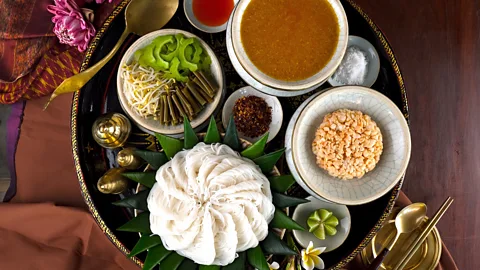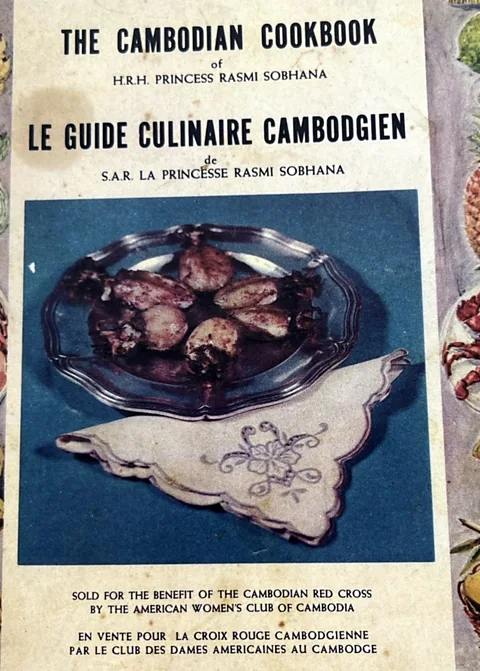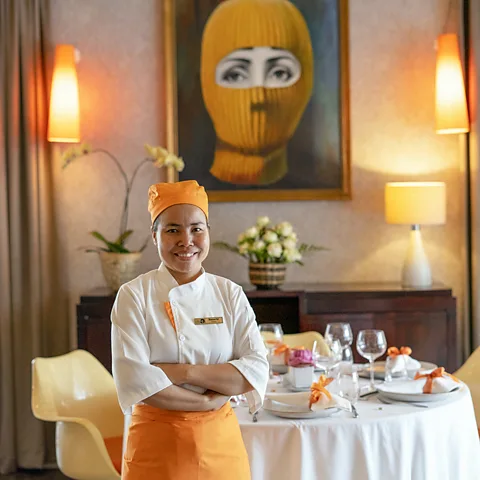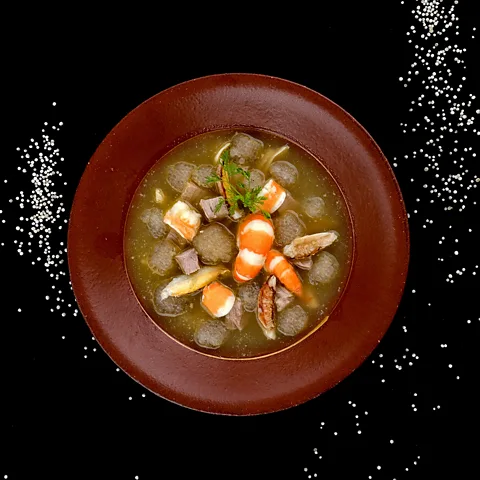The return of Cambodia's food lost during the Khmer Rouge regime
 Lamo
LamoA Cambodian chef is one of a few women looking to revive her culture's nearly forgotten Khmer recipes; her recent cookbook, Saoy, was named 'the best cookbook in the world'.
Cambodian (also known as Khmer) cuisine consists of subtle curries and fresh flavours, yet despite its palate-pleasing complexity, it has barely made it onto the international map. In recent years, however, this has begun to change, with contemporary female chefs making it their mission to preserve and share Khmer recipes and ingredients that were nearly lost during the brutal Khmer Rouge period of the 1970s, when many restrictions were placed on local foods, from eating to farming.
Leading the charge is Ros Rotanak, aka Chef Nak, one of Cambodia's few celebrity chefs. Her fascination with food began as a child, when her mum, lacking a babysitter, used to take her to sell vegetables at Doeurm Kor night market in Phnom Penh. Nowadays, the self-taught chef teaches Khmer cooking classes at her home across the Mekong River from downtown Phnom Pen.
Chef Nak, with infectious enthusiasm, describes the nuances of Khmer cooking. "The flavours are deep but balanced – sweet, salty and sour. We use a lot of sour flavours, more than just lime or citrus. For example, with tamarind, we use both the young leaf and young fruit in soup, in dipping flavours, in stir-fry."
It was on a trip to the US in 2010 that Chef Nak's desire to preserve and share Khmer cuisine started to take hold. "It was only after I travelled to the US that I realised that even though some Thai restaurants there are run by Cambodians and serve Khmer food, they don't call it Cambodian because no one knows about it. That's what ignited me to find out what's going on."
 Sarin Chhuon
Sarin ChhuonWhen she returned to Cambodia, Chef Nak embarked on a journey around the country, recording recipes from village elders. Chef Nak gathered those recipes for her 2019 cookbook, Nhum ("Eat" in the Khmer language). Most recently, her 2023 cookbook SAOY – Royal Cambodian Home Cuisine won Best of the Best Cookbook in the World at the Gourmand World Cookbook Awards.
To understand why Khmer cuisine has suffered, Dr Sambo Manara of Paññāsāstra University in Cambodia recalls the terror of the Khmer Rouge, the regime led by Marxist dictator Pol Pot starting in 1975 (termed "Year Zero"). At the time, local culture was systematically destroyed, including cuisine. Even eating at home was considered treacherous as cooking your own food was illegal. "The Khmer Rouge's restrictions on cooking at home forced many to prepare their food in secret. The consequences of being caught were serious, even fatal." The majority of people were limited to eating a thin, gruel-like porridge that wasn't enough to survive and millions of people faced starvation.
Khmer cuisine did not recover easily after the end of the regime in 1979. "In the aftermath of the Khmer Rouge era, there was a shift in culinary preferences among young people, with a growing interest in fast food and dishes influenced by foreign cultures, such as pizza or burgers," explained Dr Manara. "The declining value of Khmer food resulted in a decrease in the planting of local ingredients." The locally grown and foraged staples used in traditional dishes became increasingly harder to find, and authentic recipes began to be lost.
 Abigail Blasi
Abigail BlasiChef Nak recognised that without action, many recipes could die out in a generation. "I realised that in Cambodia, especially for food, it's a completely oral tradition," she said. "And if the young Cambodians do not take this on, it's going to go with them." This is what prompted her to film village elders making dishes such as hmok soup, a soupier version of the more common fish amok, in which local freshwater catfish is poached in kreung (lemongrass paste) and coconut cream with julienned noni leaves.
Dr Ang Chouan, a veteran Cambodian anthropologist, has observed the foodscape change gradually over recent decades. "When I was young, there weren't any Khmer restaurants in Cambodia. Most kinds of commerce were in the hands of Chinese, and especially Sino-Khmers (Chinese Cambodians)," he said. Khmer restaurants and hotels run solely by Cambodians were uncommon until the 1990s, and only recently has he seen restaurants where "Khmer foods worthy of the name are served, with a particular focus on 'refined' Khmer cuisine."
 Kimsan Pol
Kimsan PolTwo of these restaurants are headed by Kimsan Pol, another innovative female chef who has been key in changing the way Khmer food is regarded. Like Nak, Pol travels around Cambodia to rediscover Khmer cooking and authentic recipes. Her two restaurants, Embassy Restaurant in Siem Reap and Sombok in Phnom Penh feature dishes that are strikingly modern but have traditional Khmer roots with a nod to village cooking. Both restaurants are staffed and run entirely by women.
Pol explains that traditionally, Cambodian women have been housewives. She wanted to encourage women to work in hospitality and catering to promote their autonomy, but also to create a place to eat that was more than merely a restaurant. "We wanted it to feel like welcoming our friend to our home," she said.
The recipes prepared in the kitchens of Cambodia's royal families also suffered in the past half century, as royals died or fled during the Khmer Rouge. Fortunately, Cambodian Princess Rasmi Sobbhana Norodom's prescient 1960 cookbook, The Culinary Art of Cambodia, provides a wealth of traditional recipes. Rather like Chef Nak, the princess was devoted to researching Khmer cuisine. She noticed that royal court menus of the time (post French-colonial rule) were dominated by easier-to-prepare Chinese and Thai dishes, and thus set out to record roughly 170 Khmer recipes for posterity.
The book includes centuries-old dishes, such as samlor muktaa (white pearl soup). Chef Nak was thrilled to discover the rare recipe. "This dish is unusual because Cambodians typically use tapioca pearls only in desserts, but this soup is made with two types of meat (pork and chicken) and two shellfish (giant freshwater prawns and crabs) and tapioca pearls that become clear and float in the soup, making it uniquely appealing and delicious," she said.
 Lamo
Lamo"For me to rediscover dishes such as white pearl soup and be able to share them [via YouTube] with not just our Cambodian followers but also people all over the world is a remarkable story, and a source of pride," said Chef Nak. "There has to be a force of belief, an investment from a country to see food as an ambassador, to talk about the history and the stories of their people."
Pol is likewise passionate about nurturing the country's culinary soul. "We had the Khmer Rouge and we lost all the recipes, and now, with our new generation, we try to promote our food to tourists and internationally. I'm so proud that I have had the chance to introduce Cambodian food to the world."
BBC.com's World's Table "smashes the kitchen ceiling" by changing the way the world thinks about food, through the past, present and future.
---
Join more than three million BBC Travel fans by liking us on Facebook, or follow us on Twitter and Instagram.
If you liked this story, sign up for The Essential List newsletter – a handpicked selection of features, videos and can't-miss news delivered to your inbox every Friday.
